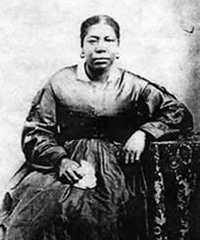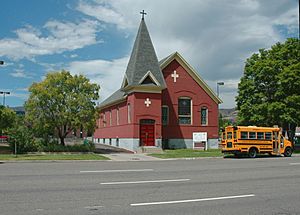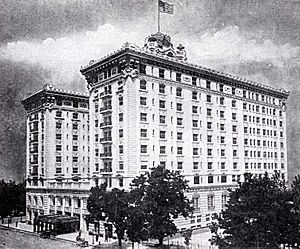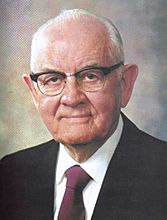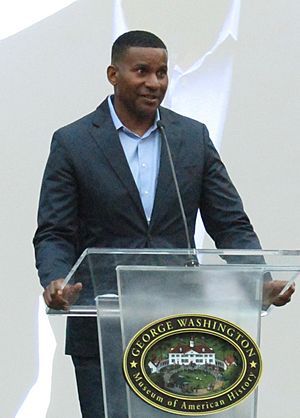History of African Americans in Utah facts for kids
African Americans first came to Utah in the early 1800s as fur trappers. Later, more African Americans arrived. Some were free people who joined The Church of Jesus Christ of Latter-day Saints. Others were slaves belonging to white settlers. Over time, many African Americans moved to Utah for work.
African Americans have always been a small part of Utah's population. In 2010, they made up about 1.06% of the state. Utah ranks 40th in the U.S. for its total African American population. It ranks 43rd for the percentage of residents who are African American.
Contents
Early African American Explorers (1800s-1847)
Before pioneers from The Church of Jesus Christ of Latter-day Saints arrived, only a few African Americans were in Utah. These were mostly fur trappers. James P. Beckwourth was one of them. He was part of William Ashley’s Rocky Mountain Fur Company. Beckwourth spent several years in Utah, especially in Cache Valley, during the 1820s.
Jedediah Smith led trips to Utah in the late 1820s. African Americans Petre Ranne and Polette Labross joined him. In 1843, a young free African American named Jacob Dodson traveled with John C. Fremont on his second trip west. This trip included the Utah territory.
African Americans Arrive with Pioneers (1847–1862)
On July 22, 1847, pioneers from The Church of Jesus Christ of Latter-day Saints entered the Salt Lake Valley. They were led by Brigham Young. They had left Missouri and Illinois because they faced harsh treatment. By the end of 1847, 12 African Americans lived in the Salt Lake Valley. Eight of them were slaves, including Oscar Crosby and Hark Lay. A family of four free African Americans, Isaac and Jane Manning James and their children, also arrived. Green Flake came with the first group of pioneers. He later helped other pioneers traveling across the plains.
By 1848, about 50 African Americans lived in the Utah Territory. Another pioneer group had arrived. Twenty-four were slaves who came from Mississippi with John Brown. Twelve other African Americans, mostly slaves, joined them from Winter Quarters in Nebraska.
In the 1850 U.S. census, 50 "colored" people lived in the Utah Territory. This was 0.4% of the total population. In 1850, the United States Congress made Utah a territory where slavery was allowed. This officially made slavery legal there.
In 1852, the Utah Legislature passed a law called the "Act in Relation to Service." This law set rules for slavery in the territory. It covered both African Americans and Native Americans. The law aimed to protect slaves' rights and ensure they were treated well. For example, it said slaves should not be moved against their will. It also said they should receive proper care and schooling. However, it also stated that slaves had to obey their masters.
Before new U.S. laws were passed, African Americans in Utah could not vote. They could not serve on juries or be elected to the legislature. They also could not serve in the military. On June 19, 1862, the U.S. Congress ended slavery in Utah and all other U.S. territories.
Life After Slavery (1862–1950)
Population Growth in Utah
| Year | Total Population | African American Population | Percentage of Population |
|---|---|---|---|
| 1860 | 40,273 | 59 | 0.15% |
| 1870 | 86,786 | 118 | 0.14% |
| 1880 | 143,963 | 232 | 0.16% |
| 1890 | 207,905 | 588 | 0.28% |
| 1900 | 276,749 | 672 | 0.25% |
| 1910 | 373,351 | 1,144 | 0.31% |
| 1920 | 449,396 | 1,446 | 0.32% |
| 1930 | 507,847 | 1,108 | 0.22% |
| 1940 | 550,310 | 1,235 | 0.22% |
| 1950 | 676,909 | 2,729 | 0.40% |
As the table shows, the number of African Americans in Utah was always small. In the late 1800s, most African Americans lived in Salt Lake City. Uintah County had the second largest group due to military bases. Weber County also had many because of the railroad center in Ogden. Unlike other western areas, African American families were common in Utah.
Before 1870, most African Americans came to Utah as converts to The Church of Jesus Christ of Latter-day Saints. After 1870, more came for work or other reasons. The number of African Americans grew, but their percentage of the population stayed low. One reason was that African Americans were not fully accepted in The Church of Jesus Christ of Latter-day Saints until 1978. This meant fewer African American converts came to Utah.
Work and Community Life
The U.S. Military and the railroads were big employers for African Americans. In 1900, many African Americans were soldiers. The next most common jobs were "servants and waiters," which included many railroad workers. Farming and mining were also common jobs.
As the African American community grew, especially in Salt Lake City and Ogden, new groups formed. African American newspapers, organizations, and churches (other than The Church of Jesus Christ of Latter-day Saints) started appearing. The first African Methodist Episcopal church in Utah opened in Salt Lake City between 1890 and 1891. It became a key place for the local African American community. In the 1890s, an African American Baptist church also started in Salt Lake.
Military Units in Utah
Two important African American military units were in Utah in the late 1800s. These were the Ninth Cavalry Regiment and the 24th Infantry Regiment. They were stationed at Fort Duchesne (Uintah County) and Salt Lake City. They helped in the Indian Wars and other duties. These units made up a large part of Utah's African American population. This is why Uintah County had the second largest African American population for a while.
Fort Duchesne had separate areas for different races. However, soldiers generally interacted with each other regardless of race.
Facing Discrimination
In 1888, Utah passed a law that made marriage between a "negro and a white person" illegal. This was called an anti-miscegenation law.
Some separation began in Utah in the late 1890s. This happened when the 24th Infantry arrived in Salt Lake. Store and restaurant owners worried about African American soldiers coming into their businesses. They started putting up signs to show their racial preferences. However, Utah schools were not officially separated by race.
Civil Rights and Desegregation (1950–1978)
The early 1950s brought big changes for African Americans in Utah. Before this, many famous African Americans faced unfair treatment when visiting Utah. This included opera singer Maria Anderson and musicians like Paul Robeson, Harry Belafonte, Ella Fitzgerald, and Lionel Hampton. The Hotel Utah made them eat outside the main restaurant. They also had to use the freight elevator. Other hotels would not let them stay. Important government officials, like U.S. Ambassador Ralph Bunche and Congressman Adam Clayton Powell, were also turned away. They had to find places to stay in private homes. Many bars, nightclubs, and restaurants in Salt Lake City refused to serve African Americans.
But this separation quickly began to end. Public places like Lagoon, an amusement park in Farmington, started allowing African Americans to enter and use all facilities.
Before the Brown v. Board of Education ruling, Utah schools and universities often did not hire African American teachers. They preferred white teachers. The NAACP said that no African American had taught in Utah's public schools until late 1954. That's when the first black public school teacher was hired. Separation also existed in college sports. This changed in 1953 when the first black football players joined the Utah State Agricultural College football team.
By 1960, the African American population in Utah had grown a lot. It was 4,148 people, making up 0.47% of Utah's total population. In 1963, Utah's 75-year ban on interracial marriage was lifted. Utah was the second-to-last state to end its anti-interracial marriage law. Wyoming ended its law in 1965.
In 1967, a newspaper interviewed African Americans in northern Utah. They shared their thoughts on racism and civil rights. Many felt that discouraging interracial marriage was wrong, even after it became legal. Students at West High School said they felt welcome and treated fairly. However, students at Ogden High School complained about unfairness from some teachers and principals. One woman was upset when a real estate agent only showed her houses in poor areas of West Salt Lake. She wanted to see homes in the mostly white, middle-class East Salt Lake.
By 1970, Utah's African American population reached 6,324. The Church of Jesus Christ of Latter-day Saints still did not allow African American men to hold the priesthood. This caused tension and criticism. David O. McKay, then President of the Church, said that a time would come when African Americans would have full rights in the church.
In June 1978, Spencer W. Kimball, the Church President, issued Official Declaration 2. This statement said that the Church believed all people are equal. It ended the practice of not allowing African American members certain church privileges. This included holding the priesthood and entering temples.
African Americans Today (1978-Present)
Population Growth
| Year | Total Population | African American Population | Percentage of Population |
|---|---|---|---|
| 1980 | 1,461,037 | 9,225 | 0.63% |
| 1990 | 1,722,850 | 11,576 | 0.67% |
| 2000 | 2,233,169 | 17,657 | 0.79% |
| 2010 | 2,763,885 | 29,287 | 1.06% |
The African American population in Utah has continued to grow quickly. By the 2010 census, it made up just over 1% of the total population.
Sports and Religion
Utah's college and professional sports teams have many African American athletes. Fans across the state often support them greatly. The Utah Jazz, an NBA team in Salt Lake City, has had famous African American players. These include Karl Malone, Paul Millsap, Donovan Mitchell, Al Jefferson, and Derrick Favors.
Sometimes, during sports rivalries in Utah, racism still appears. An African American basketball player at the University of Utah said that racial slurs are still shouted during and after games. He also reported attempts at physical harm after games.
A 2009 study showed that about 3% of members of The Church of Jesus Christ of Latter-day Saints are African American. This church is the main religion in Utah.
The Calvary Baptist Church is a well-known African American church in Salt Lake City. It has been there since 1898. A small group of African American women started it by meeting to pray. The group grew fast and moved from homes to a larger building. Reverend A. E. Reynolds was the first pastor. Membership kept growing. In 2001, a new building was built for services under Reverend France Davis. Every Sunday, about 300 African Americans gather at the Calvary Baptist Church. They receive a free breakfast and listen to Reverend Davis preach.
Modern Issues
A 2013 study showed a big difference between East Salt Lake City and West Salt Lake City. The east side is wealthier and has few African Americans or other minority groups. The west side has many more African Americans and other minorities. It is also a poorer area, with a 17.1% poverty rate.
The Salt Lake City chapter of the National Association for the Advancement of Colored People (NAACP) reported in 2017 that they receive over 10 reports of racism each week. These complaints include unfair treatment at work, the use of racial slurs, and threats of violence. Reports of racism are increasing in Utah.
Famous African Americans from Utah
- James Beckwourth - a fur trader and explorer.
- Green Flake - an early pioneer.
- Jane Manning James - an early pioneer.
- Elijah Abel - a carpenter and church leader.
- Joseph Freeman - the first African American to receive the priesthood in The Church of Jesus Christ of Latter-day Saints after the 1978 announcement.
- Wynetta Willis Martin - a singer and faculty member at BYU.
- Thurl Bailey - an NBA basketball player.
- Byron Scott - an NBA basketball coach and player.
- Alex Boyé - a singer and actor.
- Alvin B. Jackson - a state senator.
- Frank Jackson - a basketball player.
- Bryan Kehl - an NFL football player.
- Karl Malone - an NBA basketball player.
- Sandra Hollins - a Utah State Representative.
- Mia Love - a U.S. congresswoman.




